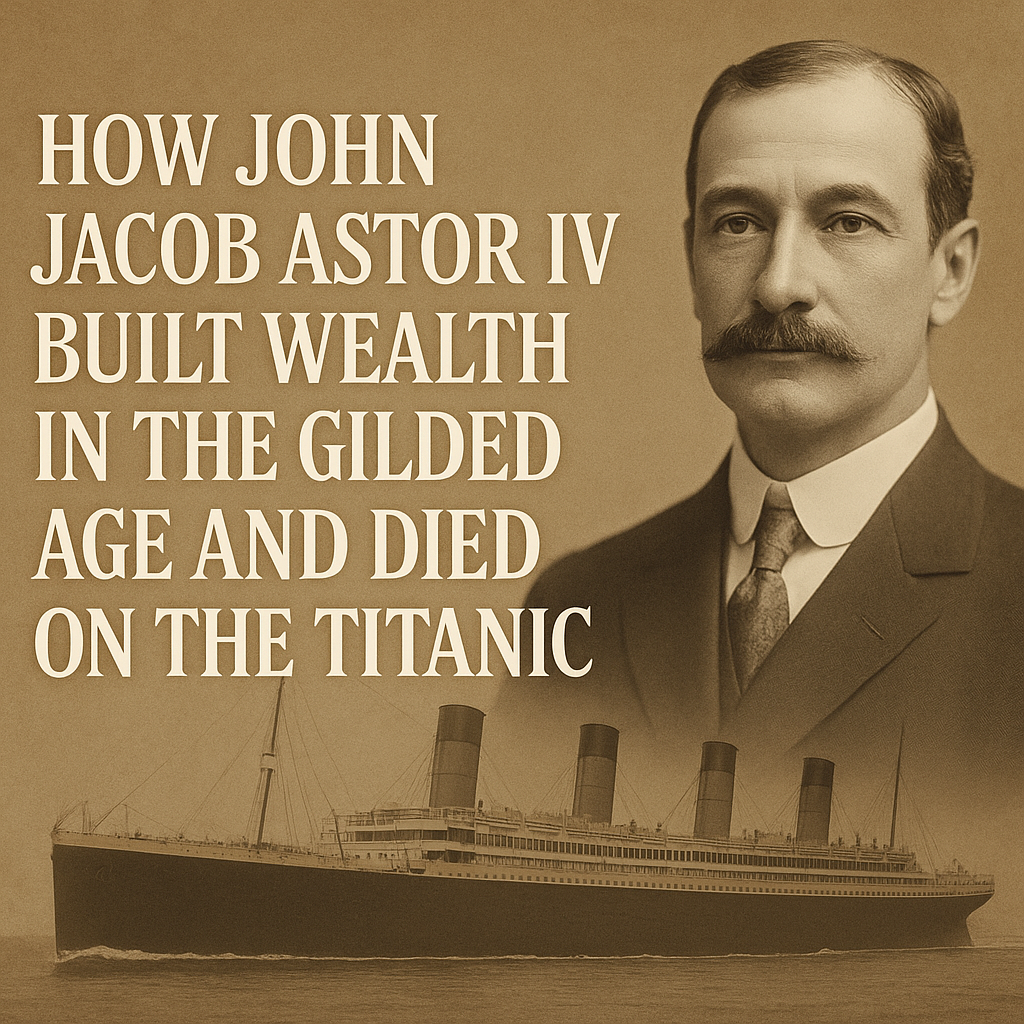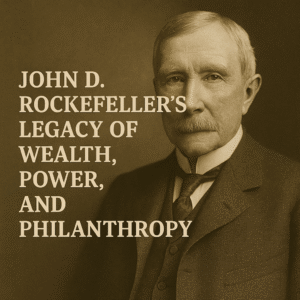John Jacob Astor IV was a titan of wealth, innovation, and society who met a tragic end aboard the Titanic. His life defined the height of American opulence.
- Born Into Riches With the Weight of Legacy
- A Mind For Invention And The Pursuit Of Innovation
- Real Estate Ventures And The Rise Of Astor Empire 2.0
- Love, Scandal, And A Controversial Second Marriage
- Titanic And The Last Hours Of A Millionaire
- Legacy Of Wealth And The Shadow Of Mortality
- Follow My Journey And Get Inspired To Transform Your Life For The Better
Born Into Riches With the Weight of Legacy
John Jacob Astor IV was born on July 13, 1864, into a family synonymous with wealth and privilege. His great-grandfather, John Jacob Astor I, had founded the Astor fortune in the early 19th century through fur trading, real estate, and astute business ventures. By the time John Jacob Astor IV entered the world, the Astors were among the richest families in America, and young Jack, as he was affectionately called, was expected to uphold the dynasty’s prestigious name.
Raised in opulence, Astor IV received a refined education, attending St. Paul’s School and later Harvard University. However, his formative years weren’t simply about indulgence. Being part of the Astor lineage meant navigating social expectations, managing a fortune, and finding ways to enhance the family’s stature in an increasingly modern and competitive world.
Even as a child, John Jacob displayed a curious mind and a penchant for invention—traits that would set him apart from the stereotypical idle rich of the Gilded Age. While his family’s legacy laid the groundwork for his wealth, Astor IV’s ambitions hinted that he intended to leave a mark of his own.
A Mind For Invention And The Pursuit Of Innovation
Though most commonly remembered as a real estate magnate and socialite, John Jacob Astor IV had a scientific and inventive streak rarely seen among the elite of his time. He held several patents, including one for a bicycle brake and another for a pneumatic road-improving machine. While these inventions didn’t transform society in the way Edison or Bell’s creations did, they reflected his desire to contribute more than just inherited wealth to the world.
Astor also wrote a science-fiction novel in 1894, titled A Journey in Other Worlds, which envisioned space travel and life on Jupiter and Saturn—a bold concept at a time when the Wright brothers hadn’t even achieved flight. The novel was a commercial curiosity and highlighted Astor’s imaginative thinking, revealing a mind that extended far beyond the confines of ballrooms and boardrooms.
Unlike many of his peers who were content to rest on their fortunes, Astor sought to be seen as more than a rich man. He wanted to be an innovator, a man who expanded the boundaries of what was possible for someone of his social station.
Real Estate Ventures And The Rise Of Astor Empire 2.0
The Astors had long been titans of Manhattan real estate, and John Jacob Astor IV inherited not only land and property but also the wisdom to turn it into even greater wealth. In the late 19th and early 20th centuries, New York was undergoing seismic changes. The skyline was rising, and the city’s social fabric was evolving.
Astor’s most ambitious and iconic contribution to this landscape was the St. Regis Hotel, completed in 1904. The St. Regis was conceived as a luxurious answer to New York’s growing elite demand for glamour and comfort. Boasting telephones in every room, a library, and extensive personal service, the hotel was hailed as a masterpiece of refinement. It wasn’t just a hotel—it was a statement of the Astor family’s continued dominance in high society.
In addition to hotels, Astor invested heavily in commercial real estate across Manhattan. His foresight in property management and urban planning allowed the Astor family to remain relevant and immensely wealthy at a time when old-money dynasties were beginning to decline. Astor IV’s leadership modernized the family’s portfolio and ensured that the Astor name retained prestige in a rapidly changing city.
Love, Scandal, And A Controversial Second Marriage
For all his public achievements, Astor’s personal life became a source of both fascination and scandal. In 1891, he married Ava Lowle Willing, a fellow member of high society, and they had two children together. But their marriage grew distant and unhappy over the years, eventually leading to a highly publicized divorce in 1909—an event still considered controversial in an era where social decorum was paramount.
What truly shocked the elite world was what followed: Astor, then 47 years old, married Madeleine Talmage Force, a 19-year-old debutante, in 1911. The age gap and the speed of the union following his divorce stirred public outrage. Newspapers buzzed with gossip, and the couple became a target of public fascination. Some criticized the match as inappropriate and unbecoming of someone in Astor’s position; others saw it as romantic and rebellious—a man following his heart, regardless of the consequences.
Despite the criticism, the couple remained close, and Madeleine became pregnant shortly after their wedding. It was in search of peace and privacy that they decided to travel abroad. When it came time to return to America, they booked a suite on a brand-new, state-of-the-art ocean liner: the RMS Titanic.
Titanic And The Last Hours Of A Millionaire
John Jacob Astor IV’s name is forever tied to one of the greatest maritime tragedies in history. On April 10, 1912, he and Madeleine boarded the Titanic in Cherbourg, France, bound for New York. They occupied one of the ship’s most luxurious suites, complete with a private promenade and personal staff. Despite the criticisms surrounding their marriage, the couple was reportedly enjoying their voyage and looking forward to the birth of their child.
When the Titanic struck an iceberg on the night of April 14, Astor’s actions during the ensuing chaos cemented his reputation as a man of integrity. According to survivor accounts, he helped his young wife into Lifeboat 4 and reportedly asked if he could join her, citing her pregnancy. The crew denied the request, and Astor reportedly stepped back, calmly accepting his fate.
What happened in the final moments of his life remains partly speculation. Some say he lit a cigarette and conversed with fellow passengers; others believe he helped more women and children into lifeboats. His body was recovered several days later, still elegantly dressed, with thousands of dollars in cash and jewelry on him—symbols of wealth that could not save him.
Astor’s death marked the end of an era. He was the richest man to perish aboard the Titanic and one of the last prominent figures of the Gilded Age to die with such tragedy and grace.
Legacy Of Wealth And The Shadow Of Mortality
Following Astor’s death, his estate was estimated to be worth over $87 million, equivalent to several billion in today’s money. His will revealed careful planning: the bulk of his fortune was left to his son Vincent, while provisions were made for Madeleine and their unborn child, John Jacob Astor VI. The division of the estate ensured the Astor wealth would continue across generations, though not without familial disputes and legal challenges.
Vincent Astor inherited the family’s business and charitable responsibilities, eventually becoming a major philanthropist. Meanwhile, young John Jacob Astor VI—born after his father’s death—grew up in the long shadow of a legacy he never personally knew. The tragedy of Titanic gave his birth symbolic weight, but he would spend much of his life wrestling with the burden of his surname and the public’s expectations.
Today, remnants of Astor IV’s influence still stand. The St. Regis remains one of the world’s most iconic luxury hotels. Streets, buildings, and foundations still carry the Astor name, a silent reminder of the man whose life bridged the old aristocratic world and the dawn of the modern age.
His story continues to capture the imagination because it fuses immense privilege with human vulnerability. For all his wealth, genius, and stature, Astor could not escape the fate that met so many on that freezing April night in the Atlantic. the 20th century and beyond. Whether viewed as a hero of industry or a ruthless capitalist, the Commodore remains one of the most important figures in the story of American business.
I am working on building a passive income stream using the internet. If you would like to do the same take a look at this business by clicking here.
This business can be operated using the internet and the start up cost is low. I don’t have to leave my current employment to work on building this global business.
If you like what you see, work with me to build a passive income stream using this global business.
I do not provide personal investment or financial advice and I am not a qualified licensed investment advisor. I am documenting my online investment and financial journey and what’s working for me. Click Here to read disclaimer.
If you found value in this post and want to support my work, click here to buy me a coffee.
Subscribe to my list for valuable updates, tools, videos and articles that I will share as I come across them.
Let me know your thoughts on this post via the comments section. You can also add your insights and suggestions.
If you enjoyed reading this post or it added some value, please share it with others.

Follow My Journey And Get Inspired To Transform Your Life For The Better
“I may earn commissions as an affiliate from sponsored links within this post”





